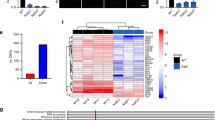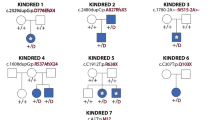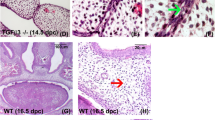Abstract
The Msx1 homeobox gene is expressed at diverse sites of epithelial–mesenchymal interaction during vertebrate embryogenesis, and has been implicated in signalling processes between tissue layers. To determine the phenotypic consequences of its deficiency, we prepared mice lacking Msx1 function. All Msx1– homozygotes manifest a cleft secondary palate, a deficiency of alveolar mandible and maxilla and a failure of tooth development. These mice also exhibit abnormalities of the nasal, frontal and parietal bones, and of the malleus in the middle ear. Msx1 thus has a critical role in mediating epithelial–mesenchymal interactions during craniofacial bone and tooth development. The Msx1–/Msx1– phenotype is similar to human cleft palate, and provides a genetic model for cleft palate and oligodontia in which the defective gene is known.
This is a preview of subscription content, access via your institution
Access options
Subscribe to this journal
Receive 12 print issues and online access
$209.00 per year
only $17.42 per issue
Buy this article
- Purchase on Springer Link
- Instant access to full article PDF
Prices may be subject to local taxes which are calculated during checkout
Similar content being viewed by others
References
Hill, R.E. et al. A new family of mouse homeo box-containing genes: molecular structure chromosomal location & developmental expression of Hox-7.1. Genes Dev. 3, 26–37 (1989).
Robert, B., Sassoon, D., Jacq, B., Gehring, W. & Buckingham, M. >Hox-7, a mouse homeobox gene with a novel pattern of expression during embryogenesis. EMBO J. 8, 91–100 (1989).
Gehring, W.J. The homeobox: Structural and evolutionary aspects, in Molecular Approaches toDevelopmental Biology (eds Firtel, R.A. & Davidson, E.H.) 115–129 (Liss, New York, 1987).
Holland, P.W.H. Cloning and evolutionary analysis of msh like homeobox genes from mouse, zebrafish and ascidian. Gene 98, 253–257 (1991).
Monaghan, A.P. et al. The Msh-like homeobox genes define domains in the developing vertebrate eye. Development 112,1053–1061 (1991).
Bell, J.R. et al. Genomic structure, chromosomal location, and evolution of the mouse Hox-8 gene. Genomics 16, 123–131 and 17, 800 (1993).
Ivens, A. et al. The human homeobox gene Hox7 maps chromosome 4p16.1 and may be implicated in Wolf-Hirschhorn syndrome. Human Genet. 84, 473–476 (1990).
Hewitt, J.E., Clark, L.N., Ivens, A. & Williamson, R. Structure and sequence of the human homeobox gene Hox7. Genomics 11, 670–678 (1991).
Jabs, E.W. et al. A mutation in the homeodomain of the human MSX2 gene in a family affected with autosomal dominant craniosynostosis. Cell 75, 443–450 (1993).
MacKenzie, A., Leeming, G.L., Jowett, A.K., Ferguson, M.W.J. & Sharpe, P.T. The homeobox gene Hox7.1 has specific regional and temporal expression patterns during early murine craniofacial embryogenesis, especially tooth development in vivo and in vitro. Development 111, 269–285 (1991).
MacKenzie, A., Ferguson, M.W.J. & Sharpe, P.T. Hox-7 expression during murine craniofacial development. Development 113, 601–611 (1991).
MacKenzie, A., Ferguson, M.W.J. & Sharpe, P.T. Expression patterns of the homeobox gene Hox 8 in the mouse embryo suggest a role in specifying tooth initiation and shape. Development 115, 403–420 (1992).
Suzuki, H.R., Padanilam, B.J., Vitale, E., Ramirez, F. & Solursh, M. Repeating developmental expression of G-Hox7, a novel homeobox-containing gene in the chicken. Dev. Biol. 148, 375–388 (1991).
Lyons, G.E., Houzelstein, D., Sassoon, D., Robert, B. & Buckingham, M. Multiple sites of Hox-7 expression during mouse embryogenesis: comparison with retinoic acid receptor mRNA localization. Molec. repro. Dev. 32, 303–314(1992).
Chan-Thomas, P.S., Thompson, R.P., Robert, B., Yacoub, M.H. & Barton, P.J.R. Expression of homeobox genes Msx-1 (Hox-7) and Msx-2 (Hox-8) during cardiac development in chick. Develop. Dyn. 197, 203–216 (1993).
Robert, B., Lyons, G., Simandl, B.K., Kuroiwa, A. & Buckingham, M. The apical ectodermal ridge regulates Hox-7 and Hox-8 gene expression in developing chick limb buds. Genes Dev. 5, 2363–2374 (1991).
Davidson, D.R., Crawley, A., Hill, R.E. & Tickle, C. Position dependent expression of two related homeobox genes in developing vertebrate limbs. Nature 352, 429–431 (1991).
Coelho, C.N.D., Krabbenhoft, K.M., Upholt, W.B., Fallon, J.F. & Kosher, R.A. Altered expression of the chicken homeobox-containing gene GHox-7 and GHox-8 in the limb buds of limbless mutant chick embryos. Development 113, 1487–1493 (1991).
Coelho, C.N.D., Upholt, W.B. & Kosher, R.A. Role of the chicken homeobox-containing genes GHox-4.6 and GHox-8 in the specification of positional identities during the development of normal and polydactylous chick limb buds. Development 115, 629–637 (1992).
Ros, M.A. et al. Apical ridge dependent and independent mesodermal domains of GHox-7 and GHox-8 expression in chick limb buds. Development 116, 811–818 (1992).
Brown, J.M. et al. Experimental analysis of the control of expression of the homeobox-gene Msx-1 in the developing limb and face. Development 119, 41–48 (1993).
Takahashi, Y., Bontoux, M. & Le Douarin, N.M. Epithelio-mesenchymal interactions are critical for Quox 7 expression and membrane bone differentiation in the neural crest derived mandibular mesenchyme. EMBOJ. 10, 2387–2393(1991).
Jowett, A.K., Vainio, S., Ferguson, M.W.J., Sharpe, P.T. & Thesleff, I. Epithelial-mesenchymal interactions are required for msx1 and msx2 gene expression in the developing murine molar tooth. Development 117, 461–470(1993).
Takahashi, Y., Monsoro-Burg, A.-H., Bontoux, M. & Le Douarin, N.M. A role for Quox-8 in the establishment of the dorsoventral pattern during vertebrate development. Proc. natn. Acad. Sci. U.S.A. 89, 10237–10241 (1992).
Davidson, D.R. & Hill, R.E. Msh-like genes: a family of homeobox genes with wide ranging expression during vertebrate development. Sem. Dev. Biol. 2, 405–412 (1991).
Muneoka, K. & Sasoon, D. Molecular aspects of regeneration in developing vertebrate limbs. Dev. Biol. 152, 37–49 (1992).
Izpisúa-Belmonte, J.-C. & Duboule, D. Homeobox genes and pattern formation in the vertebrate limb. Dev. Biol. 152, 26–36 (1992).
Davidson, E.H. Later embryogenesis: regulatory circuitry in morphogenetic fields. Development 118, 665–690 (1993).
Robert, B. et al. Induction phenomena in vertebrate limb formation and expression of homeobox genes. Ann. Génétique 36, 39–45 (1993).
Gorlin, R.J., Cohen, M.M.Jr., & Levin, L.S. Syndromes of the Head and Neck. Oxford Monograph on Medical genetics No. 19, Third edition. 693–714 (Oxford University Press, Oxford, England, 1990).
Ranta, R. A review of tooth formation in children with cleft lip/palate. A. J. Orthod. Dentofac. Orthop. 90, 11–18 (1986).
Randall, P., Krogman, W.M. & Jahina, S., Robin and the syndrome that bears his name. Cleft Palate J. 2, 237–246 (1965).
McKusick, V.A. Mendelian Inheritance in Man. 8th edn 1138–1139 (Johns Hopkins University Press, Baltimore 1988).
Couly, G. and Le Douarin, N.M. The fate map of the cephalic neural primordium at the presomitic to the 3-somite stage in the avian embryo. Development Supp. 103, 101–113 (1988).
Couly, G.F., Coltey, P.M. & Le Douarin, N.M. The triple origin of skull in higher vertebrates: a study in quail-chick chimeras. Development 117, 409–429 (1993).
Noden, D.M. Interactions and fates of avian craniofacial mesenchyme. Development Supp. 103, 121–140 (1988).
Lumsden, A.G.S. Spatial organization of the epithelium and the role of neural crest cells in the initiation of the mammalian tooth germ. Development Supp. 103, 155–169 (1988).
Johnston, M.C. The neural crest in abnormalities of the face and brain. Birth Defects: Original Article Series, Vol. Xl(7), 1 18 (The National March of Dimes Foundation, 1975).
Sulik, K.K., Cook, C.S. & Webster, W.S. Teratogenesis and craniofacial malformations: relationships to cell death. Development Supp. 103, 213–232 (1988).
Palmer, R.M. & Lumsden, A.G.S. Development of periodontal ligament and alveolar bone in homografted recombinations of enamel organs and papillary, pulpal and follicular mesenchyme in the mouse. Arch. Oral Biol. 32, 281–289 (1987).
Vainio, S., Karavanova, I., Jowett, A. & Thesleff, I. Identification of BMP-4 as a signal mediating secondary induction between epithelial and mesenchymal tissues during early tooth development. Cell 75, 45–58 (1993).
Coelho, C.N.D. et al. Expression of the chicken homeobox-containing gene GHox-8 during embryonic chick limb development. Mech. Dev. 34, 143–154 (1991).
Coelho, C.N.D., Sumoy, L., Kosher, R.A. & Upholt, W.B., GHox-7: A chicken homeobox-containing gene expressed in a fashion consistent with a role in patterning events during embryonic chick limb development. Differentiation 49, 85–92 (1992).
Ferguson, M. Palate development. Development Supp. 103, 41–60 (1988).
Fitch, N. Development of cleft palate in mice homozygous for the shorthead mutation. J. Morphot. 109, 151–157 (1961).
Seegmiller, R.E. & Fraser, F.C. Mandibular growth retardation as a cause of cleft palate in mice homozygous for the chondrodysplasia gene. J. Embryol. exp. Morph. 38, 227–238 (1977).
Juriloff, D.M. & Harris, M.J. Abnormal facial development in the mouse mutant first arch. J. Cranio. Gen. devl. Biol. 3, 317–337 (1983).
Culiat, C.T. et al. Concordance between isolated cleft palate in mice and alterations within a region including the gene encoding the β3 subunit of the type Aγ-aminobutyric acid receptor. Proc. natn. Acad. Sci. U.S.A. 90, 5105–5109(1993).
Nakatsu, Y. et al. A cluster of three GABA receptor subunit genes is deleted in a neurological mutant of the mouse p locus. Nature 364, 448–450 (1993).
Gendron-Maguire, M. et al. Hoxa-2 mutant mice exhibit homeotic transformation of skeletal elements derived from cranial neural crest. Cell 75, 1317–1331 (1993).
Rijli, F.M. et al. A homeotic transformation is generated in the rostral branchial region of the head by disruption of Hoxa-2, which acts as a homeotic selector gene. Cell 75, 1333–1349 (1993).
Farrall, M. & Holder, S. Familal recurrence-pattern analysis of cleft lip with or without cleft palate. Am. J. hum. Gen. 50, 270–277 (1992).
Marazita, M.L., Hu, D-N, Spence, M.A., Liu, Y-E., Melnick, M. Cleft lip with or without cleft palate in Shanghai, China: evidence for an autosomal major locus. Am. J. hum. Gen. 51, 648–653 (1992).
Kurnit, D.M., Layton, W.M. & Matthysse, S., Genetics, chance, and morphogenesis. Am. J. hum. Gen. 41, 979–995 (1987).
Li, E., Bestor, T. & Jaenisch, R. argeted mutation of the DNA methyl transferase gene results in embryonic lethality. Cell 69, 915–926 (1992).
Zijlstra, M., Li, E., Sajjadi, F., Subramani, S. & Jaensich, R. Germ line transmission of adisrupted β2-microglobulin gene produced by homologous recombination in embryonic stem cells. Nature 342, 435–438 (1989).
Robertson, E.J. Embryo-derived stem cell lines in Teratocarcinomas and embryonic stem cells a practical approach (ed. Roberston. E.J.)71–112(IRL press, Oxford, 1987).
Thomas, K. & Capecchi, M. Site directed mutagenesis by gene targeting in mouse embryo derived stem cells. Cell 51, 503–512 (1987).
Bradley, A. Production and analysis of chimaeric mice. in Teratocarcinomas and embryonic stem cells, a practical approach (ed. Robertson, E.J.) 113–151 (IRL Press, Oxford, 1987).
Laird, P.W. et al. Simplified mammalian DNA isolation procedure. Nuc. Acid Res. 19, 4293 (1991).
McLeod, M.J. Differential staining of cartilage and bone in whole mouse fetuses by alcian blue and alizarin red S. Teratology 22, 299–301 (1980).
Author information
Authors and Affiliations
Rights and permissions
About this article
Cite this article
Satokata, I., Maas, R. Msx1 deficient mice exhibit cleft palate and abnormalities of craniofacial and tooth development. Nat Genet 6, 348–356 (1994). https://doi.org/10.1038/ng0494-348
Received:
Accepted:
Issue Date:
DOI: https://doi.org/10.1038/ng0494-348
This article is cited by
-
The genetic basis of hypodontia in dental development
British Dental Journal (2023)
-
Tooth number abnormality: from bench to bedside
International Journal of Oral Science (2023)
-
Development of a novel ex vivo organ culture system to improve preservation methods of regenerative tissues
Scientific Reports (2023)
-
Pitfalls of whole exome sequencing in undefined clinical conditions with a suspected genetic etiology
Genes & Genomics (2023)
-
Family and case–control genetic study of MSX1 polymorphisms in peg-shaped teeth Jordanian population
BMC Oral Health (2022)



